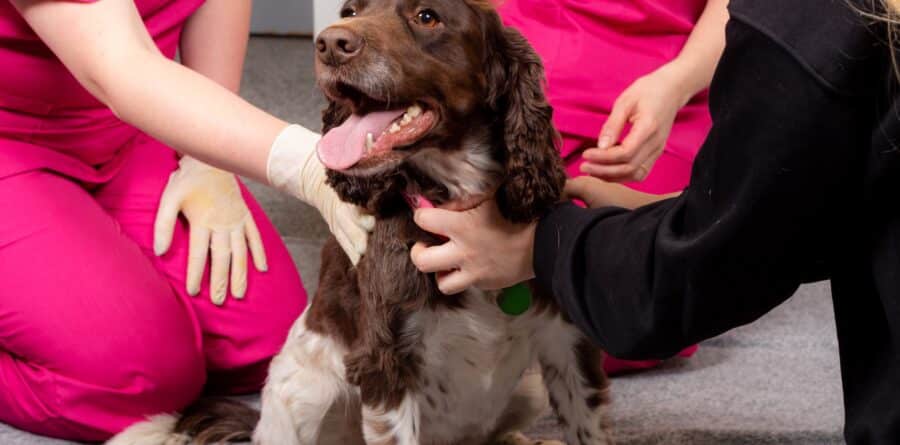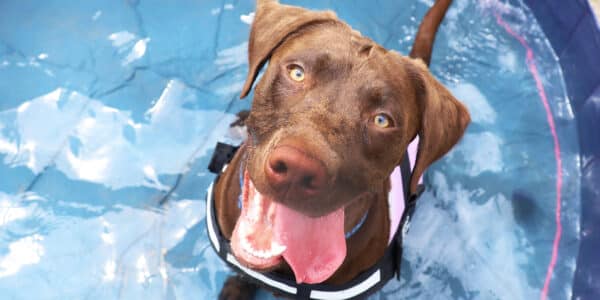Fat or furry? How to keep the extra inches off of your dog
5/03/2023 - PDSA

PDSA Vet Nurse, Shauna Walsh, shares expert insight into some of the UK’s popular dog breeds and how to know if your four-legged friend is carrying extra weight around the edges.
“It sounds obvious, but dogs who eat too much and don’t exercise enough, get fat! If you feed your dog a lot of treats as well as their normal food, most of the extra calories will turn into excess inches.”
“It can be easy to dismiss any extra weight on your dog, especially if their fluffy coat hides the excess pounds! With images of plump pooches – tubby terriers or rotund retrievers being increasingly showcased and viewed as ‘normal’, it can be difficult to know what a healthy shape is for your dog.”
Dogs come in all different builds and sizes depending on their breed-type, but a healthy shape is the same for every dog. Your dog’s body shape will help to give you an idea of whether they’re carrying too much weight. The veterinary term for this is ‘Body Condition Scoring’ (BCS), and it is simple and easy to do at home with your canine companion:
- Run your hands along your dog’s sides. The skin should move freely over the ribs, which you should be able to feel with a light touch.
- Run your hands along your dog’s back. You should be able to feel the spine and hipbones under the skin without being able to see them – they shouldn’t be sticking out.
- Gently feel the base of your dog’s tail, there shouldn’t be a build-up of fat where the tail joins the spine.
- Feel under your dog’s tummy, it should go in, not bulge out.
- Look at your dog from the side and from above. You should be able to see a waist. If not, your dog may be overweight.
Knowing your pet’s body condition score helps you to know if they need to lose some pounds, but it’s also important to know your pet’s current weight – use both together to work out what their ideal weight should be. Weighing them regularly means you can quickly spot any changes, and then tweak their diet and exercise to correct it. You can visit your vet to weigh larger dogs, and small dogs can also be weighed at home quite easily using bathroom scales.
Maintaining a healthy weight is down to feeding the right amounts of a balanced diet, as well as appropriate levels of exercise. Shauna advises: “All dogs need daily exercise, but how much they need depends on lots of factors, including their age, breed, fitness level and any health conditions they may have. Every dog is an individual, so it is very important to consider your dog’s specific needs when exercising them – young dogs won’t need as much exercise as they grow, and that may be the same for some senior dogs, who could benefit from resting their aging paws! For dogs with health concerns, the levels of exercise they need will be best discussed with your vet and adjusted appropriately.
“Unless your vet advises otherwise, all dogs need at least one walk a day for their physical and mental health – some dogs prefer a long leisurely walk, and others prefer multiple shorter walks split up throughout the day. You can also incorporate games and playtime into your dog’s daily routine to keep things fun in-between walks.”
Your dog’s breed plays a large part in their natural energy levels, which affects how much exercise they need. Some high-energy breeds need significantly more exercise than others, as well as mental stimulation throughout the day. Flat-faced breeds such as Pugs, Bulldogs, and Shih Tzu’s still need exercise, but often struggle to breathe due to the shape of their face so they need extra consideration to not over-exert them during walks and playtime.
Very high-energy breeds
These breeds are ideal for active owners who will take them out on adventures and make sure they have plenty to do all the time. They need plenty of varied exercise opportunities every day and we recommend spreading these across the day in several walks to have a good sniff around, with off-lead time on top. As well as keeping their paws active, you want to keep their brains busy, too! Make sure you have plenty of time to play with your dog, have training sessions and create some games that will really challenge their minds to prevent them from getting bored. Popular very high energy breeds include: Labradors, Siberian Huskies, Border Collies, German Shepherds, Dalmatians and Golden Retrievers.
High-energy breeds
Whilst these breeds still require plenty of exercise opportunities, they may want a little more downtime than the very high-energy breeds. They will still want daily varied exercise, on top of some brain games to provide mental stimulation, however will also appreciate some time to relax and rest their paws, more than breeds with more energy to burn! Popular high energy breeds include: Whippets, Poodles, French Bulldogs and Cocker Spaniels.
Moderate-energy breeds
Although these breeds aren’t known for bouncing off of the walls with energy, they will still require a good amount of exercise in order to keep them fit, active and healthy. All dogs, regardless of energy levels still require exercise, as well as mental stimulation to avoid becoming a couch potato! If your dog prefers a gentle plod over a run around, be sure to offer plenty of brain games for them to participate in. Popular moderate-energy breeds include: Dachshunds, Chihuahuas, Yorkshire Terriers and King Charles Spaniels.
Being a healthy weight and shape will improve your pet’s quality of life, as they can enjoy walks and activity, which in turn improves their mental health, and can delay the onset of long-term diseases, helping them to live longer.
Shauna added: “it can feel like a big challenge to get a pet to lose weight or keep off the pounds, but trust us, it’s worth it for the long term – we all want our dogs to be in our lives for as long as possible! When your dog is their ideal size and shape, they will be healthier, happier and more active. They will also have the best chance of living a long, healthy life. If you are struggling with your pet’s weight, contact your vet for help and advice.”
PDSA Big Weigh In has launched in partnership with Royal Canin – the aim is to help pets live a better and hopefully longer life, by maintaining a healthy weight. Pet owners across the UK are invited to join in and visit a participating practice for a free weight check throughout February and March.
PDSA has also launched the PDSA #WeighUp Pet Weight Loss Support Group, for fellow pet owners to join, share their progress and access exclusive tips and content, including weekly Q&As with PDSA vets and vet nurses, all to help each pet owner with their pet’s weight loss journey.
To find out more before visiting your local participating practice, please visit PDSA’s website.
All articles on this news site are submitted by registered contributors of EssexWire. Find out how to subscribe and submit your stories here »

